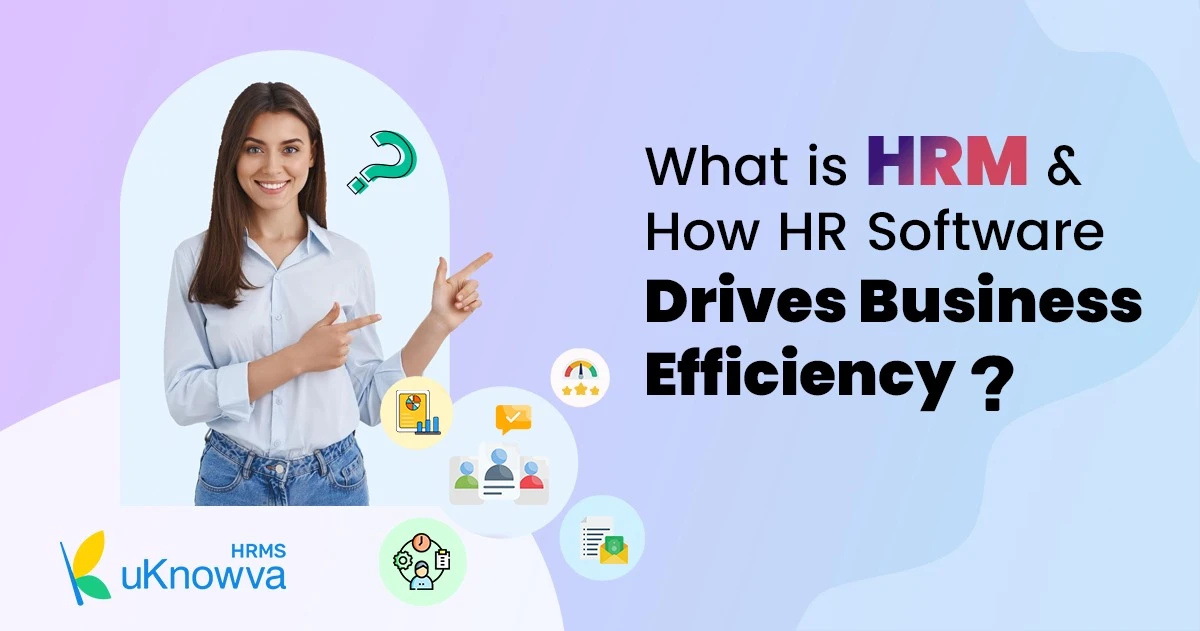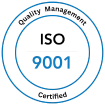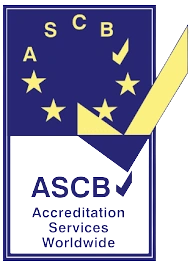Table of Content
- What is Human Resource Management (HRM)?
- A Historical Perspective
- How does Human Resource Management work?
- Why is Human Resource Management Important?
- 7 Key Functions of HRM
- Learning the Difference Between HR and HRM
- Challenges Faced by Traditional HR Practices
- HR Technology for Businesses: A Game Changer
- Evaluate Different Software Types: HRIS, HCM, HRMS
- Benefits of Using HRM Software
- Case study: Delhivery
- How to Choose the Right Human Resource Management Solution?
- The Power of HR Digital Transformation
- The Future of HRM
- Conclusion
- FAQs on What is HRM(Human Resource Management)
A fast-growing startup begins hiring like wildfire, onboarding a new team every other week. But soon, chaos ensues—payroll errors, poor communication, missed deadlines, and disgruntled employees.
Why?
Because there's no HR system in place.
This is where the magic of Human Resource Management (HRM) and digital HR tools comes in. In today’s world, managing people without technology is like driving a car with no steering—dangerous and inefficient.
Today, we’ll unpack the essence of HRM, why it’s vital for any business (big or small), and how HR software—especially tailored HRM tools for small businesses—can transform operations, boost productivity, and future-proof your organisation.

What is Human Resource Management (HRM)?
Human Resource Management (HRM) is the discipline that combines both the art and science of effectively managing people within an organisation. It’s not just about hiring or firing. It’s about building a system where every employee thrives, grows, and contributes to the bigger picture.
In simpler terms, HRM is everything related to:
- Hiring the right people
- Developing them through training
- Rewarding performance
- Managing workplace culture
- Ensuring compliance with labour laws
And when done right, it becomes the backbone of a productive and happy organisation.
A Historical Perspective
There was a time when HR departments were overwhelmed with mountains of paperwork. HR managers spent most of their time dealing with files, forms, and manual calculations.
But fast-forward to the 21st century—HR has become more digital, strategic, and data-driven than ever before.
With the rise of HR automation tools and people analytics, today’s HR teams are expected to deliver real business value, not just handle admin tasks.
How does Human Resource Management work?
Human Resource Management (HRM) works by strategically managing people within an organisation to boost productivity and support business goals.
It begins with workforce planning and recruitment, where HR identifies talent needs and hires suitable candidates. Once employees are onboarded, HRM focuses on training, performance evaluation, and skill development.
Key functions include managing payroll, attendance, leave, and employee benefits. HR also ensures compliance with labor laws and internal policies to avoid legal risks.
Through performance reviews, feedback, and employee engagement activities, HRM fosters a motivated and efficient workforce.
Modern HRMS platforms like uKnowva HRMS streamline these processes with automation, dashboards, and real-time data, making HR tasks faster and more accurate.
Why is Human Resource Management Important?
-
The Core Role in Business Success
Think about any successful company. What’s common across them? A great product? Maybe. But always—an engaged, high-performing team. That’s what HRM nurtures.
It aligns people's strategies with business objectives. When HR functions run smoothly, teams are more focused, productive, and innovative. HRM ensures you’re not just building a company, but a culture.
-
HRM’s Contribution to Organisational Culture
Culture eats strategy for breakfast. HRM helps build workplace culture by influencing values, leadership approaches, and communication practices. It fosters an environment of inclusion, openness, and trust.
When employees feel genuinely acknowledged and their input is valued, they are more likely to be motivated and perform at their highest potential.
-
Driving Employee Engagement and Retention
Organisations with strong employee engagement experience a 21% increase in profitability. To retain top talent and lower turnover rates, HRM leverages tools such as pulse surveys, employee recognition systems, and structured career development plans.
7 Key Functions of HRM
-
Recruitment and Onboarding
The first impression matters. HRM streamlines recruitment through smart tools that help identify the best candidates quickly. Applicant tracking systems (ATS), resume parsers, and automated interview schedulers save time and reduce bias.
Onboarding software ensures new hires are welcomed, trained, and integrated faster—with everything from digital welcome kits to task checklists.
-
Learning and Development
Modern HRM goes beyond training sessions. It provides online learning tools, competency evaluations, and customised development pathways. With AI-based recommendations, employees can upskill in real-time, enhancing their contribution to the business.
-
Performance Management
Annual reviews are dead. Today, it’s about providing continuous feedback, conducting 360-degree reviews, and establishing clear KPIs.
HR management software now tracks goals, identifies performance gaps, and suggests training—turning average performers into top ones.
-
Payroll and Benefits Administration
Imagine if your salary was delayed or wrongly credited—annoying, right? HR automation tools eliminate errors, ensure timely payouts, calculate taxes, and manage employee benefits—all in a few clicks.
-
Employee Relations and Conflict Resolution
Every workplace has disagreements. HRM provides structured approaches for resolving conflicts, conducting mediations, and addressing employee grievances.
Digital HR systems promote transparency and maintain thorough documentation, helping to reduce legal liabilities.
-
Workforce Management and Compliance
From managing work shifts and holidays to adhering to labour laws—HRM ensures your business stays compliant. Workforce management software tracks attendance, leaves, and overtime, and also assists during audits.
-
HR Data Analytics and Strategic Planning
Modern HRM systems collect and analyse workforce data to support informed decision-making.
With insights into employee turnover, engagement levels, hiring trends, and productivity metrics, HR teams can forecast future workforce needs, improve retention strategies, and align HR goals with overall business objectives.
Data-driven HR transforms the department from administrative to strategic.
Learning the Difference Between HR and HRM
Let’s clear the confusion: “HR” is the department; “HRM” is the philosophy and system it operates under.
- HR: The team that handles people operations.
- HRM: The structured approach and strategy guide those operations.
Think of HRM as the master plan and HR as the team executing it.
Challenges Faced by Traditional HR Practices
-
Manual Processes and Paperwork
Manual HR is slow, messy, and error-prone. It consumes valuable time, causes delays, and often results in subpar employee experiences.
-
Lack of Real-time Data and Insights
Without digital dashboards or people analytics, decision-making becomes instinct-based rather than data-driven. That’s risky in today’s hyper-competitive landscape.
-
Compliance and Risk Management
From labour law violations to GDPR breaches, outdated HR practices expose businesses to hefty penalties. Modern HR tech safeguards you against such pitfalls.
HR Technology for Businesses: A Game Changer
-
Rise of HR Automation Tools
From auto-generating offer letters to sending birthday wishes, automation handles routine tasks, so HR teams can focus on strategy. Tools like chatbots, automated workflows, and integrated platforms bring speed, accuracy, and delight.
-
Role of HR Management Software
Platforms like uKnowva HRMS or BambooHR offer dashboards for everything—leave approvals, performance tracking, announcements, and even mood surveys! This centralises HR activities and improves transparency across teams.
-
Why HRM Tools for Small Businesses Matter
Small teams don’t have big HR departments. That’s why agile HRM tools help owners and managers do more with less—saving money, avoiding compliance issues, and improving employee morale.
Evaluate Different Software Types: HRIS, HCM, HRMS
When it comes to HR software, terms like HRIS, HCM, and HRMS are often used interchangeably, but they each serve slightly different purposes:
-
HRIS (Human Resource Information System)
Primarily focuses on storing employee data such as personal details, job titles, benefits, and compliance records.
It primarily focuses on administrative functions and is most effective for managing essential HR duties such as payroll processing, tracking attendance, and maintaining employee records.
-
HCM (Human Capital Management)
Offers a broader, strategic perspective. It includes all HRIS functionalities but also covers talent management, performance tracking, learning and development, and succession planning. It’s ideal for workforce development and planning.
-
HRMS (Human Resource Management System)
This is a more all-encompassing solution that integrates the functionalities of both HRIS and HCM systems. It often includes advanced tools like AI-powered automation, workflow engines, mobile access, employee self-service, and engagement modules.
Platforms like uKnowva HRMS fall under this category, offering both administrative and strategic features.
Benefits of Using HRM Software
- Centralised Data Management – One source of truth for all employee records.
- Time & Cost Efficiency – Automation reduces manual errors and administrative workload.
- Improved Compliance – Stay aligned with labor laws and internal policies.
- Enhanced Employee Experience – Self-service portals and mobile apps offer convenience.
- Smarter Decision-Making – Data analytics and reports provide valuable HR insights.
- Scalability – Easily adapt to changing workforce size and structure.
- Seamless Workflow Automation – Speeds up approvals, onboarding, and task tracking.
Case study: Delhivery
uKnowva HRMS helped Delhivery streamline and digitise their HR operations for a large and diverse workforce spread across the country.
Previously dependent on manual tools like Excel and disconnected systems, Delhivery faced challenges in onboarding, attendance tracking, and vendor coordination. uKnowva introduced automated onboarding using QR-code scanning, making the process faster and more secure.
The platform enabled smarter manpower planning by allowing vacancy requests only within approved budgets, reducing unnecessary hiring.
It also offered complete vendor billing integration to eliminate manual errors and overcharging. Attendance manipulation was minimised with real-time shift-based onboarding and strict controls on backdated entries. The system ensured seamless data flow across departments and improved transparency in approvals, billing, and exits.
Overall, uKnowva HRMS empowered Delhivery with end-to-end automation, boosting workforce efficiency, compliance, and accuracy in operations, especially critical for a fast-paced logistics company managing both permanent and off-roll employees nationwide.
Read: How uKnowva streamlined HR operations for Delhivery
How to Choose the Right Human Resource Management Solution?
- Assess Your Business Needs – Are you focusing on basic HR tasks, talent management, or both?
- Look for Scalability – Ensure the software can grow with your team.
- Evaluate Features – Prioritise modules like payroll, attendance, performance, and engagement.
- User Experience Matters – Easy-to-use UI for both HR teams and employees.
- Integration Capabilities – Should work well with other tools like accounting or ERP software.
- Mobile Accessibility – Especially important for a remote or hybrid workforce.
- Vendor Support – Check for onboarding help, training, and ongoing support.
- Security & Compliance – The software must ensure data privacy and align with regulatory standards.
- Budget – Go for a cost-effective yet feature-rich solution like uKnowva HRMS.
The Power of HR Digital Transformation
-
Smarter Hiring with AI-Powered Tools
AI-based hiring software can scan hundreds of resumes, match skills with job requirements, and even predict candidate longevity. This reduces hiring costs and improves quality.
-
People Analytics for Smarter Decision-Making
Want to know who’s ready for promotion or who might quit soon? People analytics uncovers trends within the workforce, enabling HR to make informed, data-driven strategic decisions.
-
Enhancing HR Efficiency through Automation
Automated HR systems reduce errors by up to 80%. Tasks like timesheet approvals, birthday greetings, or compliance checks happen without reminders, freeing up time for real human connection.
The Future of HRM
-
Embracing Cloud-Based Solutions
Cloud HR platforms are accessible from anywhere—perfect for hybrid teams. No hardware costs, no manual backups, just seamless HR operations.
-
Integrating People-First Culture with Tech
Today’s workforce craves connection and empathy. HR software now includes wellness trackers, feedback tools, and mental health support modules to support holistic well-being.
-
HR’s Role in Business Strategy
HR leaders are now part of boardroom conversations. From diversity goals to business forecasting, HRM is driving measurable outcomes and shaping the company’s future.
Conclusion
So, what is HRM in today’s business world? It’s more than a department—it’s a strategic partner that drives efficiency, employee satisfaction, and business growth.
The right HR management software bridges the gap between people and performance. Whether you're a startup founder or an HR professional in a growing firm, adopting modern HR tools isn’t just a good idea—it’s a necessity.
Don’t let manual processes hold you back. Embrace HR digital transformation and turn your people into your biggest business asset.
FAQs on What is HRM(Human Resource Management)
-
What is HRM in simple terms?
HRM, or Human Resource Management, is the process of managing people at work. It involves hiring, training, evaluating, and supporting employees to ensure they perform well and stay engaged with the company.
-
How does HRM contribute to business efficiency?
HRM improves efficiency by aligning employee goals with company objectives, automating repetitive tasks, managing performance, and fostering a positive work environment, helping the business run smoothly and productively.
-
What are the key functions of HRM?
HRM covers multiple functions such as:
- Recruitment and onboarding
- Training and development
- Payroll and compensation
- Employee relations
- Compliance and legal management
- Performance reviews and workforce planning
-
What is HR management software?
HR management software is a digital tool that automates HR tasks like payroll processing, attendance tracking, leave approvals, and employee data management. It streamlines operations and saves time for HR teams and business owners.
-
How does HR software improve decision-making?
Modern HR software includes analytics and reporting tools that provide real-time insights on employee performance, attrition trends, training needs, and more—helping managers make smarter, data-driven decisions.
-
Is HR software suitable for small businesses?
Absolutely. HRM tools for small businesses help streamline operations without needing a large HR team. These tools are often affordable, scalable, and designed to simplify complex processes like hiring, payroll, and compliance.
-
What is HR automation, and how does it help?
HR automation refers to using software to handle repetitive tasks like sending onboarding emails, processing leave requests, or updating records. It reduces human error, saves time, and boosts HR efficiency.
-
How does HR software support remote or hybrid teams?
Cloud-based HR platforms enable employees and managers to access HR services from anywhere. They support digital attendance, virtual onboarding, e-learning, and remote performance reviews, ensuring seamless HR management across locations
-
What role does HRM play in employee retention?
HRM helps retain talent by fostering a positive workplace culture, offering growth opportunities, managing fair compensation, and addressing employee concerns—leading to higher satisfaction and lower turnover.
-
What’s the future of HRM with technology?
The future of HRM lies in AI-driven tools, people analytics, cloud-based systems, and a people-first approach. As tech evolves, HR will become even more strategic—driving business outcomes through smarter, more human-centric solutions.












